NCERT Solutions for Class 6 Maths Chapter 4 - Data Handling and Presentation
Ever wondered how cricketers track their scores or how weather reports are made? It is all with the help of data handling and presentation. In NCERT Solutions for Class 6 Maths Chapter 4 Data Handling and Presentation, students will learn about basic concepts regarding data management, how to present data, the various techniques involved, and much more. These NCERT Solutions for Class 6 Maths provide the step-by-step solutions for all the questions asked in each chapter in the Class 6 book. In the solutions of this chapter, there are questions relating to the concepts of Collecting and Organising Data, Pictographs, and Bar Graphs.
This Story also Contains
- NCERT Solutions for Class 6 Maths Chapter 4 Data Handling and Presentation: Download Free PDF
- NCERT Solutions for Class 6 Maths Chapter 4 Data Handling and Presentation: Exercise
- NCERT Data Handling and Presentation Class 6 Maths Chapter 4: Topics:
- Class 6 Maths Chapter 4 Data Handling and Presentation solutions: Extra Question
- NCERT Solutions for Class 6 Maths Chapter 4 Data Handling and Presentation - Notes
- NCERT Solutions for Class 6 Maths Chapter 4 Data Handling and Presentation - Points to Remember
- Why are Class 6 Maths Chapter 4 Data Handling and Presentation question answers important?
- NCERT Solutions for Class 6 Maths Chapter Wise
- NCERT Books and the NCERT Syllabus

Math is not just about numbers, but also about making sense of what they mean. Graphs and charts turn boring numbers into exciting pictures. These Data Handling and Presentation Class 6 NCERT Solutions help students prepare for exams by practising numerous questions and checking their answers. Many teachers recommend NCERT Solutions because they closely match the exam pattern. These NCERT Solutions for Class 6 are a reliable resource as they are created with respect to the latest NCERT Syllabus by the subject matter experts at Careers360. For detailed solutions, complete syllabus notes, and a free PDF download, refer to this NCERT article.
NCERT Solutions for Class 6 Maths Chapter 4 Data Handling and Presentation: Download Free PDF
Careers360 brings you NCERT Solutions for Class 6 Maths Chapter 4, carefully prepared by subject experts to simplify your studies and help in exams. A downloadable PDF has been provided — click on the link below to access it.
NCERT Solutions for Class 6 Maths Chapter 4 Data Handling and Presentation: Exercise
Careers360 experts have prepared these NCERT Class 6 Maths Chapter 4 Data Handling and Presentation solutions to make learning maths easier and help you do better in class and exams.
|
Data Handling and Presentation Class 6 Question Answers Page No: 75 Questions: 4 |
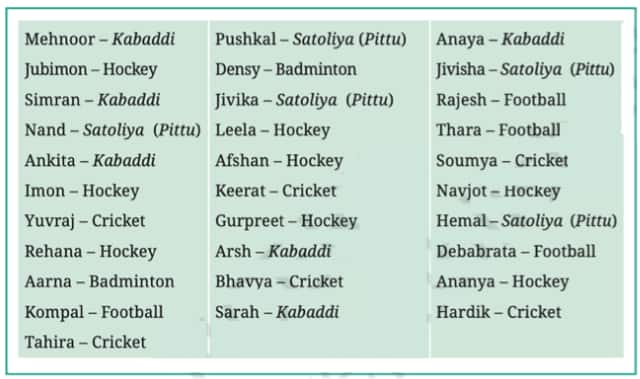
Q1. What would you do to find the most popular game among Naresh's and Navya's classmates?
Solution: To find the most popular game, we will first arrange the table of games according to their frequency or repetition in the table. The game with the highest frequency will be the most popular game among students.
| Game | Number of students (frequency) |
| Kabaddi | 6 |
| Hockey | 8 |
| Satoliya (Pittu) | 5 |
| Cricket | 6 |
| Badminton | 2 |
| Football | 4 |
Q2. What is the most popular game in their class?
Solution: As you can see from the table, the most popular game in the class is Hockey with the highest frequency, i.e. 8.
Q3. Try to find out the most popular game among your classmates.
Solution: Do it Yourself [DIY] {Hint: Prepare a table and find the game with the highest frequency.}
Q4. Pari wants to respond to the questions given below. Put a tick (✓) for the questions where she needs to carry out data collection and put a cross (×) for the questions where she doesn't need to collect data. Discuss your answers in the classroom.
a. What is the most popular TV show among her classmates?
b. When did India get independence?
c. How much water is getting wasted in her locality?
d. What is the capital of India?
Solution:
a. Yes, she needs to collect the data to form a table showing the frequency of each show.
b. 15th August 1947. (No data collection is required)
c. Yes, she needs to collect the data from her neighbourhood to form a table showing the amount of water wasted.
d. New Delhi. (No data collection is required)
|
Data Handling and Presentation Class 6 Question Answers Page No: 76 Questions: 2 |
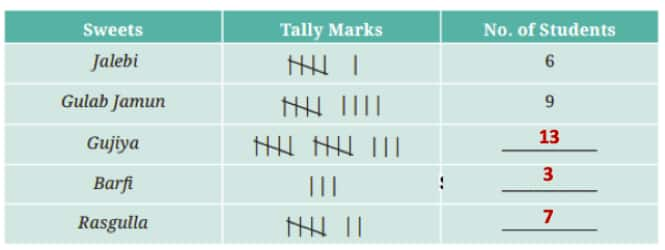
Q1. Complete the table to help Shri Nilesh purchase the correct number of sweets:
a. How many students chose jalebi? ◻
b. Barfi was chosen by ◻ students?
c. How many students chose gujiya? ◻
d. Rasgulla was chosen by ◻ students?
e. How many students chose gulab jamun? ◻
Shri Nilesh requested one of the staff members to bring the sweets as given in the table. The above table helped him to purchase the correct number of sweets.
Solution: According to the given data in the table. Count the lines of the Tally mark to find the number of students.
a. 6
b. 3
c. 13
d. 7
e. 9
Q2. Is the above table sufficient to distribute each type of sweet to the correct student? Explain. If it is not sufficient, what is the alternative?
Solution: No, the table is not sufficient for the distribution of each type of sweet. With this table, you need a list of the names of students according to their choice.
|
Data Handling and Presentation Class 6 Question Answers Page No: 77 Questions: 5 |
Sushri Sandhya asked her students about the sizes of the shoes they wear. She noted the data on the board.
She then arranged the shoe sizes of the students in ascending order -

3, 3, 3, 4, 4, 4, 4, 4, 4, 4, 4, 4, 5, 5, 5, 5, 5, 5, 5, 5, 5, 5, 6, 6, 6, 6, 7
Q1. Help her figure out the following:
a. The largest shoe size in the class is_________.
b. The smallest shoe size in the class is___________.
c. There are _________ students who wear shoe size 5.
d. There are ___________ students who wear shoe sizes larger than 4.
Solution:
a. 7
b. 3
c. 10
d. 15
Q2. How did arranging the data in ascending order help to answer these questions?
Solution: Arranging the data helped us to find the smallest size and the largest size. Also enabled us to find the frequency of the sizes.
Q3. Are there other ways to arrange the data?
Solution: Yes, by arranging the data in decreasing order or using the Tally Mark Table.
For example:
Descending order:
7, 6, 6, 6, 6, 5, 5, 5, 5, 5, 5, 5, 5, 5, 5, 4, 4, 4, 4, 4, 4, 4, 4, 4, 3, 3, 3
Q4. Write the names of a few trees you see around you. When you observe a tree on the way from your home to school (or while walking from one place to another place), record the data and fill in the following table:
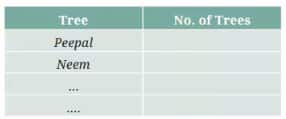
a. Which tree was found in the greatest number?
b. Which tree was found in the smallest number?
c. Were there any two trees found in the same numbers?
Solution:
You can solve these questions by following the given steps:
(1) Write down the names of the trees.
(2) Write the count of each tree in front of the tree.
Now, you will be able to answer the given questions.
Q5. Take a blank piece of paper and paste any small news item from a newspaper. Each student may use a different article. Now, prepare a table on the piece of paper as given below. Count the number of each of the letters 'c', 'e', 'i, 'r', and ' x ' in the words of the news article, and fill in the table.

a. The letter found the most number of times is ________.
b. The letter found the least number of times is ________.
c. List the five letters 'c', 'e', 'i ', 'r', ' x ' in ascending order of frequency. Now, compare the order of your list with that of your classmates. Is your order the same or nearly the same as theirs? (Almost everyone is likely to get the order ' x,c,r, i, e'.) Why do you think this is the case?
d. Write the process you followed to complete this task.
e. Discuss with your friends the processes they followed.
f. If you do this task with another news item, what process would you follow?
Solution: Do It Yourself [DIY Time]
|
Data Handling and Presentation Class 6 Question Answers Page No: 83 Questions: 2 |
Q1. The following pictograph shows the number of books borrowed by students in a week from the library of Middle School, Ginnori:
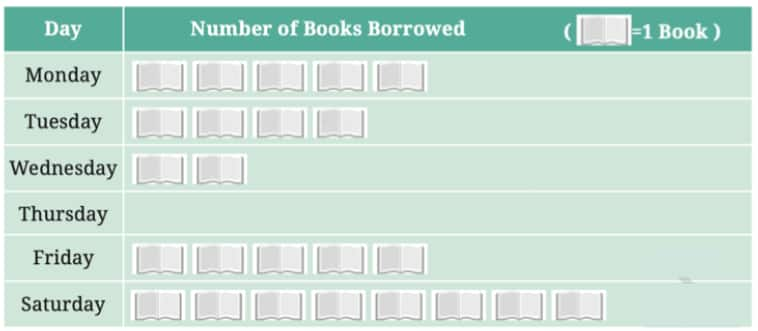
a. On which day was the minimum number of books borrowed?
b. What was the total number of books borrowed during the week?
c. On which day was the maximum number of books borrowed? What may be the possible reason?
Solution:
a. Thursday (0 books)
b. 5 + 4 + 2 + 0 + 5 + 8 = 24
c. Saturday (8 books), it may be possible due to the free periods, as it is the last day of the week and the next day is Sunday, so that students may get time to read.
Q2. Magan Bhai sells kites at Jamnagar. Six shopkeepers from nearby villages come to purchase kites from him. The number of kites he sold to these six shopkeepers is given below -
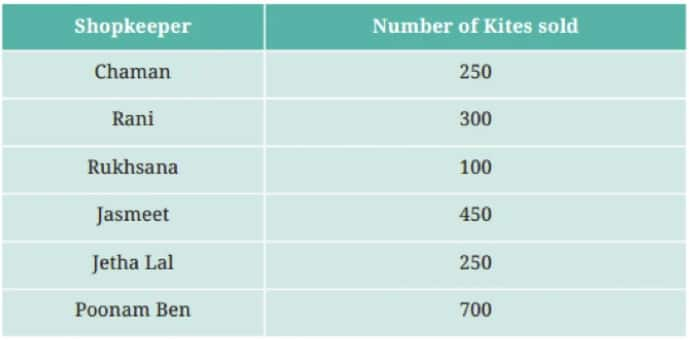
Prepare a pictograph using the symbol ![]() to represent 100 kites. Answer the following questions:
to represent 100 kites. Answer the following questions:
a. How many symbols represent the kites that Rani purchased?
b. Who purchased the maximum number of kites?
c. Who purchased more kites, Jasmeet or Chaman?
d. Rukhsana says Poonam Ben purchased more than double the number of kites that Rani purchased. Is she correct? Why?
Solution:
|
Chaman |
|
|
Rani |
|
|
Ruksana |
|
|
Jasmeet |
|
|
Jetha Lal |
|
|
Poonam Ben |
|
a. 3
b. Poonam Ben
c. Jasmeet
d. Yes, Rani bought 300 kites, whereas Poonam Ben bought 700 kites, which is more than twice that of Rani.
|
Data Handling and Presentation Class 6 Question Answers Page No: 88 Questions: 4 |
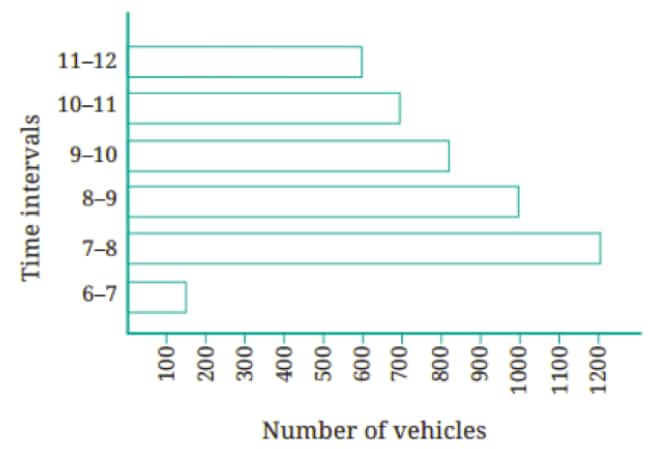
Q1. How many total cars passed through the crossing between 6 a.m. and noon?
Q2. Why do you think so little traffic occurred during the hour of 6-7 a.m., as compared to the other hours from 7 a.m. to noon?
Q3. Why do you think the traffic was the heaviest between 7−8 a.m.?
Q4. Why do you think the traffic was less and less each hour after 8 a.m. until noon?
Solution:
-
4470
-
It is because fewer people go to work.
-
It is because all the adults and children start going to their places.
-
It is because the number of school-going children is reducing.
|
Data Handling and Presentation Class 6 Question Answers Page No: 93 Questions: 11 |
Q1. Samantha visited a tea garden and collected data on the insects and critters she saw there. Here is the data she collected:

Help her prepare a bar graph representing this data.
Solution:
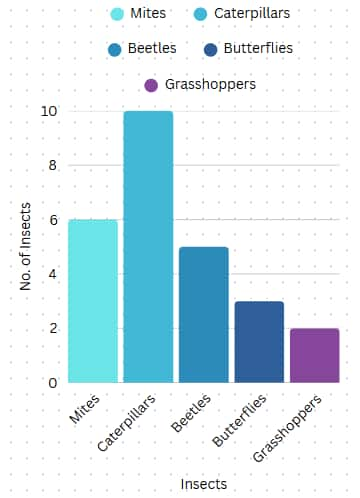
Q2. Pooja collected data on the number of tickets sold at the Bhopal railway station for a few different cities of Madhya Pradesh over two hours.

She used this data and prepared a bar graph on the board to discuss the data with her students, but someone erased a portion of the graph.
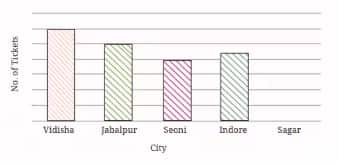
a. Write the number of tickets sold for Vidisha above the bar.
b. Write the number of tickets sold for Jabalpur above the bar.
c. The bar for Vidisha is 6 unit lengths, and the bar for Jabalpur is 5 unit lengths. What is the scale for this graph?
d. Draw the correct bar for Sagar.
e. Add the scale of the bar graph by placing the correct numbers on the vertical axis.
f. Are the bars for Seoni and Indore correct in this graph? If not, draw the correct bar(s).
Solution:
(a and b).
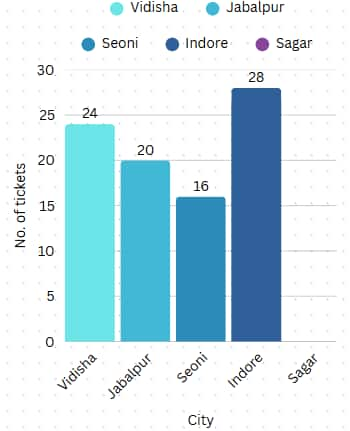
c. Vidisha 6 units = 24 tickets
∴ Vidisha 1 unit = 246⇒4
Jabalpur 5 units = 20 tickets
∴ Jabalpur 1 unit = 205⇒4
Hence, 1 unit = 4 tickets
(d, e).
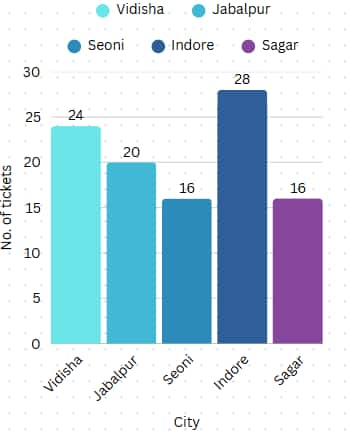
f. The graph of Seoni was correct, but the graph of Indore was not. So, the correct graph is
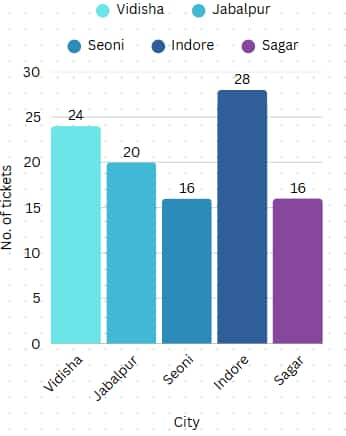
Q3. Chinu listed the various means of transport that passed across the road in front of his house from 9 a.m. to 10 a.m:
a. Prepare a frequency distribution table for the data.
b. Which means of transport was used the most?
c. If you were there to collect this data, how could you do it? Write the steps or process.
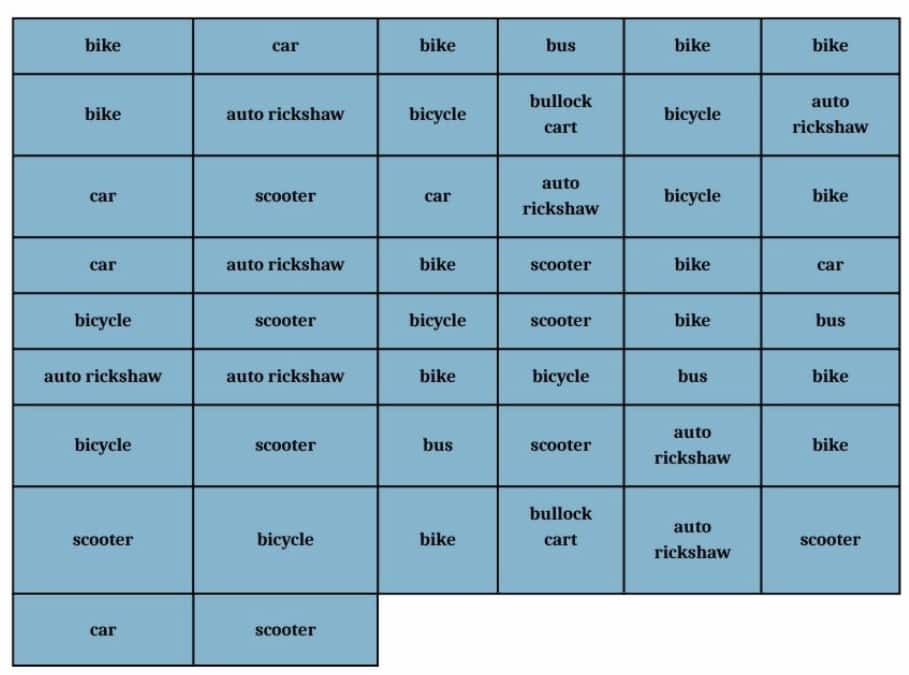
Solution:
a.
|
Medium of Transport |
Frequency |
Tally Marks |
|---|---|---|
|
Bike |
13 |
|
|
Car |
6 |
|
|
Bus |
4 |
|
|
Auto |
8 |
|
|
Bicycle |
8 |
|
|
Bullock cart |
2 |
|
|
Scooter |
9 |
|
b. Bike (13 times)
c.
Step 1: Write down the mode of transport in the first column.
Step 2: Counting the vehicles passing between 9 am to 10 am.
Step 3: Write down the number of vehicles of each type in front of the vehicle.
Step 4: Draw a bar graph to represent the data.
Q4. Roll a die 30 times and record the number you obtain each time. Prepare a frequency distribution table using tally marks. Find the number that appeared:
a. The minimum number of times.
b. The maximum number of times.
c. Find numbers that appeared an equal number of times.
Solution: DIY [Take a reference from solution 3 (a)]
Q5. Faiz prepared a frequency distribution table of data on the number of wickets taken by Jaspreet Bumrah in his last 30 matches:
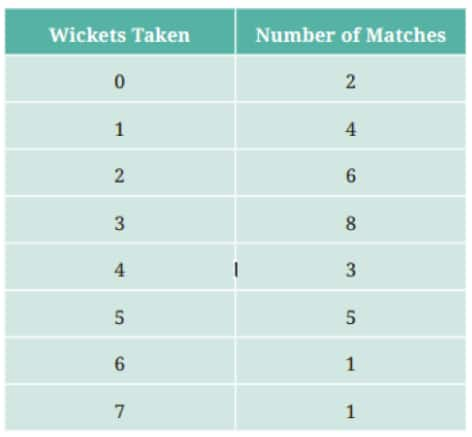
a. What information is this table giving?
b. What may be the title of this table?
c. What caught your attention in this table?
d. In how many matches has Bumrah taken 4 wickets?
e. Mayank says, "If we want to know the total number of wickets he has taken in his last 30 matches, we have to add the numbers 0,1,2,3…, up to 7 ." Can Mayank get the total number of wickets taken in this way? Why?
f. How would you correctly figure out the total number of wickets taken by Bumrah in his last 30 matches, using this table?
Solution:
a. The table gives information about the number of wickets taken by Jasprit Bumrah in several matches.
b. The title of the table can be given as “Distribution of Wickets taken by Jaspreet Bumrah per match”.
c. In this table, the most eye-catching thing is the consistent performance by Jasprit Bumrah, who took 5 wickets in 5 matches.
d. 3 Matches
e. No, by adding all the wickets, we can’t find the total number of wickets taken by Bumrah. To find the total number of wickets, we need to multiply the number of matches by the number of wickets in each row, and then we need to add the results of each row.
f. To find the total number of wickets, we need to multiply the number of matches by the number of wickets.
So, total wickets taken by Bumrah = 0×2+1×4+2×6+3×8+4×3+5×5+6×1+7×1 =0+4+12+24+12+25+6+7=90
Q6. The following pictograph shows the number of tractors in five different villages.
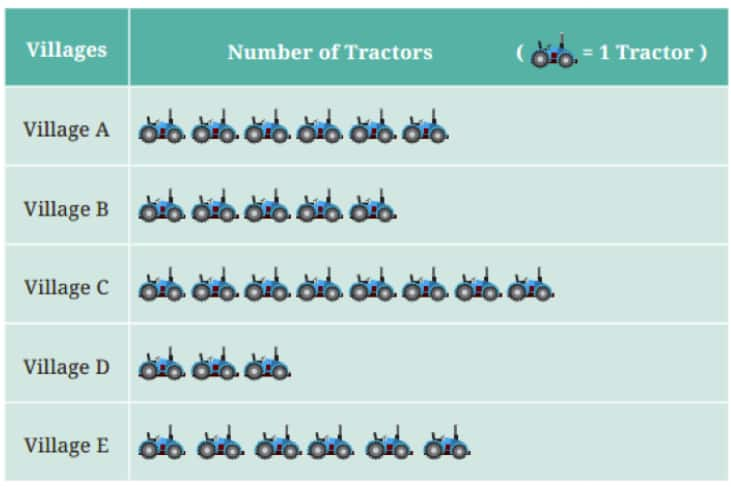
Observe the pictograph and answer the following questions-
a. Which village has the smallest number of tractors?
b. Which village has the most tractors?
c. How many more tractors does Village C have than Village B?
d. Komal says, "Village D has half the number of tractors as Village E." Is she right?
Solution:
a. Village D (3 tractors)
b. Village C (8 tractors)
c. The difference in the number of tractors of Village C and Village B = Village C - Village B = 8 - 5 = 3
d. Village E has 6 tractors, whereas Village D has 3 tractors. So, yes, Village D has exactly half the number of tractors as Village E.
Q7. The number of girl students in each class of a school is depicted by the pictograph:
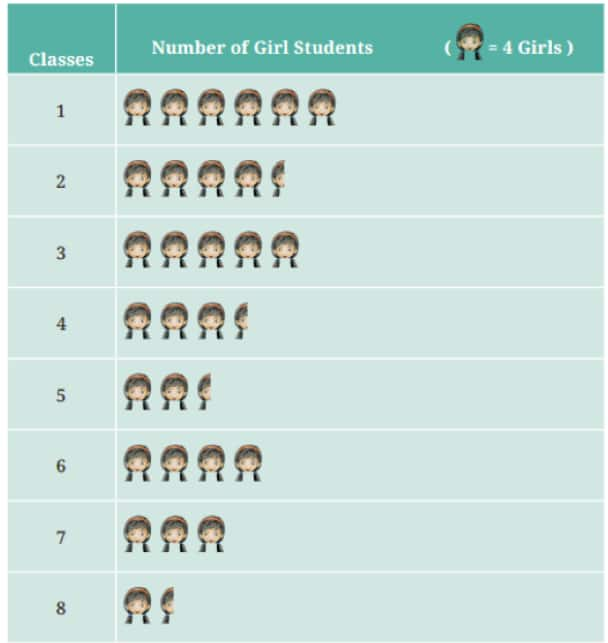
Observe this pictograph and answer the following questions:
a. Which class has the least number of girl students?
b. What is the difference between the number of girls in Class 5 and 6?
c. If two more girls were admitted in Class 2, how would the graph change?
d. How many girls are there in Class 7?
Solution:
a. Class 8 has the fewest number of girls.
b. Number of girls in Class 6 -Number of girls in Class 5 = 16 - 10 = 6
c. Then Class 2 will have 20 students with 5 symbols in the table.
d. Class 7 has 3 complete symbols, i.e. it has 12 girls.
Q8. Mudhol Hounds (a type of breed of Indian dogs) are largely found in North Karnataka's Bagalkote and Vijayapura districts. The government took an initiative to protect this breed by providing support to those who adopted these dogs. Due to this initiative, the number of these dogs increased. The number of Mudhol dogs in six villages of Karnataka is as follows-
Village A :18, Village B : 36 , Village C : 12, Village D : 48 , Village E : 18 , Village F : 24
Prepare a pictograph and answer the following questions:
a. What will be a useful scale or key to draw this pictograph?
b. How many symbols will you use to represent the dogs in Village B?
c. Kamini said that the number of these dogs in Village B and Village D together will be more than the number of these dogs in the other 4 villages. Is she right? Give reasons for your response.
Solution:
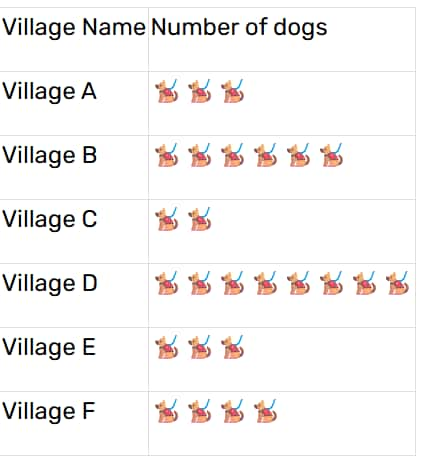
b. 6 Symbols are used to depict the number of dogs in Village B.
c. Village B + Village D = 14 symbols.
∴ It is more than the number of dogs in other villages.
Q9. A survey of 120 school students was conducted to find out which activity they preferred to do in their free time:
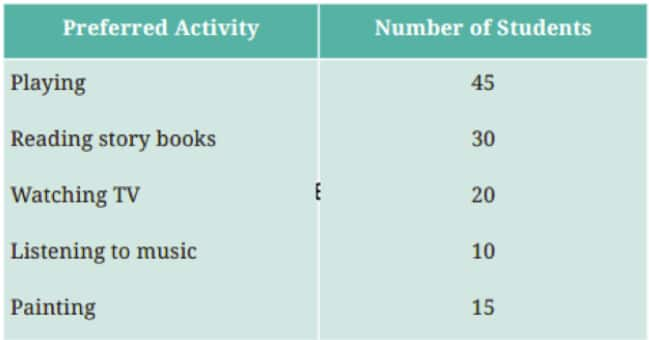
Draw a bar graph to illustrate the above data, taking the scale of 1 unit length = 5 students. Which activity is preferred by most students other than playing?
Solution:
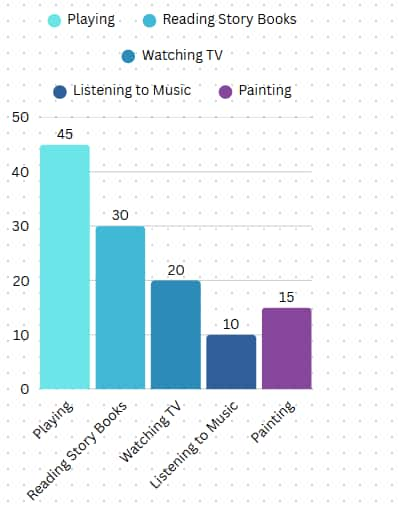
Reading storybooks is the other most preferred activity over playing.
Q10. Students and teachers of a primary school decided to plant tree saplings in the school campus and in the surrounding village during the first week of July. Details of the saplings they planted are as follows-
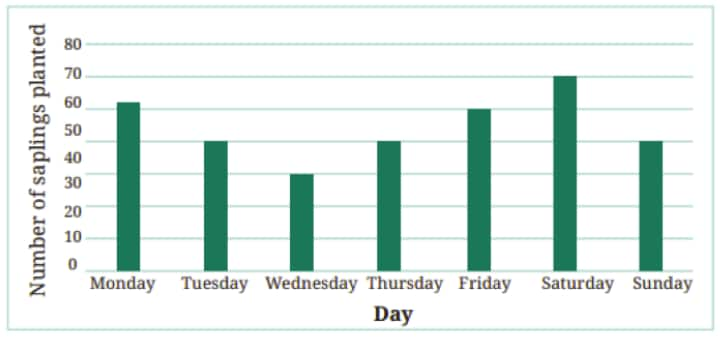
a. The total number of saplings planted on Wednesday and Thursday is __________.
b. The total number of saplings planted during the whole week is __________.
c. The greatest number of saplings was planted on ______ and the least was planted on __________. Why do you think that is the case? Why were more saplings planted on certain days of the week and fewer on others? Can you think of possible explanations or reasons? How are your explanations correct?
Solutions:
a. Wednesday + Thursday = 30 + 40 = 70
b. 52 + 40 + 30 + 40 + 50 + 60 + 40 = 312
c. The greatest number of saplings was planted on Saturday, and the least was planted on Wednesday. In most of the schools, Saturdays have fewer classes and the next day is a holiday. So, most saplings are done on Saturdays.
The reasoning may differ according to the schools and their curriculum.
Q11. The number of tigers in India went down drastically between 1900 and 1970. Project Tiger was launched in 1973 to track and protect the tigers in India. Starting in 2006, the exact number of tigers in India was tracked. Shagufta and Divya looked up information about the number of tigers in India between 2006 and 2022 in four-year intervals. They prepared a frequency table for this data and a bar graph to present this data, but there are a few mistakes in the graph. Can you find those mistakes and fix them?
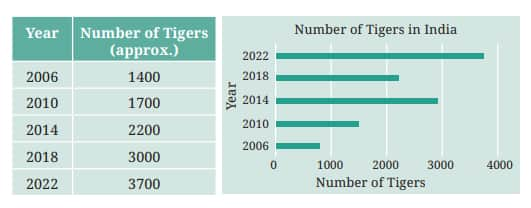
Solution: Yes, in the bar graph, the data is not represented in the correct manner.
∴ The correct graph is:
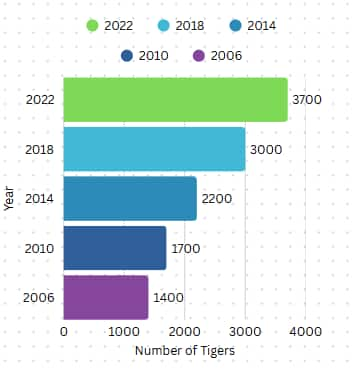
|
Data Handling and Presentation Class 6 Question Answers Page No: 103 Questions: 2 |
Q1. If you wanted to visually represent the data of the heights of the tallest persons in each class in your school, would you use a graph with vertical bars or horizontal bars? Why?
Solution: A bar graph featuring vertical bars is utilised to visually depict the height data of the tallest individuals in each class. It is more intuitive and visually attractive to display heights measured from the ground using bar graphs with vertical bars.
Q2. If you were making a table of the longest rivers on each continent and their lengths, would you prefer to use a bar graph with vertical bars or with horizontal bars? Why? Try finding out this information, and then make the corresponding table and bar graph! Which continents have the longest rivers?
Solution: To prepare a table listing the longest rivers on each continent, along with their lengths, a horizontal bar graph is utilised. This is because lengths parallel to the ground are typically best represented using bar graphs with horizontal bars.
NCERT Data Handling and Presentation Class 6 Maths Chapter 4: Topics:
Students will explore the following topics in NCERT Class 6 Maths Chapter 4 Data Handling and Presentation:
4.1 Collecting and Organising Data
4.2 Pictographs
4.3 Bar Graphs
4.4 Drawing a Bar Graph
4.5 Artistic and Aesthetic Considerations
Class 6 Maths Chapter 4 Data Handling and Presentation solutions: Extra Question
Question:
The following bar graph shows the number of accidents that happened in a city during the year 2021.
How many Buses and Cars combined were sold in the year 2021?
Solution:
Total buses sold in 2021 = 180
Total Cars sold in 2021 = 200
Total = 200 + 180 = 380
Hence, the correct answer is 380.
NCERT Solutions for Class 6 Maths Chapter 4 Data Handling and Presentation - Notes
Careers360 has prepared these Class 6 Data Handling and Presentation Notes to make your revision smoother and faster. Also, these notes will help students to understand the Data Handling and Presentation NCERT solutions and solve them on their own from next time.
Data: Data can be defined as any collection of facts, numbers, measures, observations or other descriptions of things that convey information about those things in particular. Data is a collection of similar pieces of information. For example, if we go around our class and collect information about the favourite subject of every student, it is data.
Representation of Data: The data is represented in various ways, like tally marks, pictographs and bar graphs.
Tally marks: Tally marks are a set of lines that are used to represent the data.
Pictographs: Pictographs are a pictorial representation of data using symbols and pictures. These are a visual and suggestive way to represent data without writing any numbers.
NCERT Solutions for Class 6 Maths Chapter 4 Data Handling and Presentation - Points to Remember
Check the following important points to understand and solve the Class 6 Maths Chapter 4 Data Handling and Presentation question answers effectively.
Data: Data is a collection of similar pieces of information.
Tally marks: Tally marks are a set of lines that are used to represent the occurrence of data.
Pictographs: Pictographs are a pictorial representation of data using symbols and pictures.
Bar Graphs: Bar graphs are a graphical representation of data using vertical or horizontal bars.
Why are Class 6 Maths Chapter 4 Data Handling and Presentation question answers important?
Data handling and presentation chapter introduces students to the world of bar graphs, tables, and pictographs. These are very important concepts to present data neatly and meaningfully. Here are some more points on why we should practice Class 6 Maths Data Handling and Presentation question answers efficiently.
- Students learn how to collect, organise and interpret data logically after practising these questions. This is a useful skill both in maths and real life.
- Data handling is used in many real-life scenarios, such as sports scores, weather reports, surveys, and business, so learning it early helps students understand real-world data.
- Later on, students will find the chapter “Data interpretation” with these same concepts, along with some other charts.
- This chapter also lays the groundwork for statistics for higher classes, while improving students' reasoning and visual understanding skills.
NCERT Solutions for Class 6 Maths Chapter Wise
Access all NCERT Class 6 Maths solutions from one place using the links below.
NCERT Books and the NCERT Syllabus
Download NCERT books and check the syllabus for Class 6 Maths from the links given below.
Frequently Asked Questions (FAQs)
Here are some recommended books that will help you understand the basic concepts of Data Handling and Presentation, and solve problems related to this.
- NCERT Class 6 Maths Textbook
- R.S. Aggarwal’s Class 6 Maths
- RD Sharma Class 6 Mathematics
- Arihant’s Mathematics for Class 6
Data is usually arranged in a table or tally chart for easier counting and comparison.
Proper labelling in a Bar graph helps in understanding what each bar and axis represent, making data interpretation accurate and clear.
Data handling is used in weather reports, sports statistics, business charts, school attendance records, and population studies.
Yes. These NCERT Solutions cover all the textbook questions. If students practice them well, they will be ready for exams.
The main topics that students will learn in NCERT Class 6 Chapter 4 Data Handling and Presentation are:
- Collecting and Organising Data
- Pictographs
- Bar Graphs
- Artistic and Aesthetic Considerations
Bar Graph: Data is represented using bars of different heights or lengths to compare different categories. Bar graphs are generally better for precise comparisons and when dealing with numerical data.
Pictogram: Uses pictures or symbols to represent data. A pictogram is considered more visually engaging for students.
Yes. We at Careers360 have solved and provided all the NCERT class 6 Chapter 4 exercises in one place for easy student reference. These solutions are explained in a student-friendly manner, and step-by-step explanations are given so that each student can understand why it is solved in that way.
Courses After 12th
Applications for Admissions are open.
As per latest syllabus. Physics formulas, equations, & laws of class 11 & 12th chapters
JEE Main Important Chemistry formulas
Get nowAs per latest syllabus. Chemistry formulas, equations, & laws of class 11 & 12th chapters
JEE Main high scoring chapters and topics
Get nowAs per latest 2024 syllabus. Study 40% syllabus and score upto 100% marks in JEE
JEE Main Important Mathematics Formulas
Get nowAs per latest syllabus. Maths formulas, equations, & theorems of class 11 & 12th chapters



























